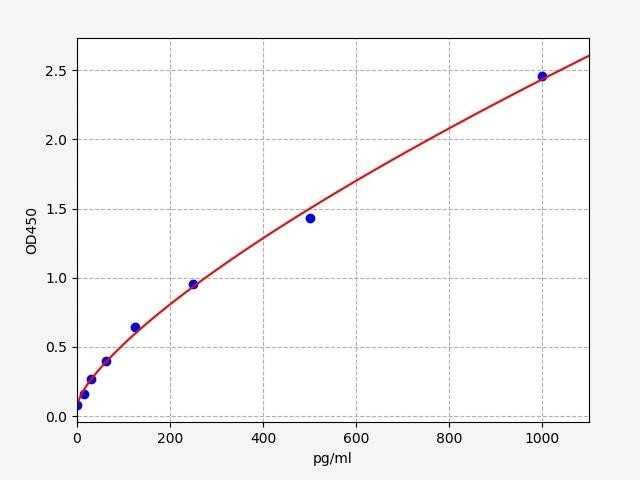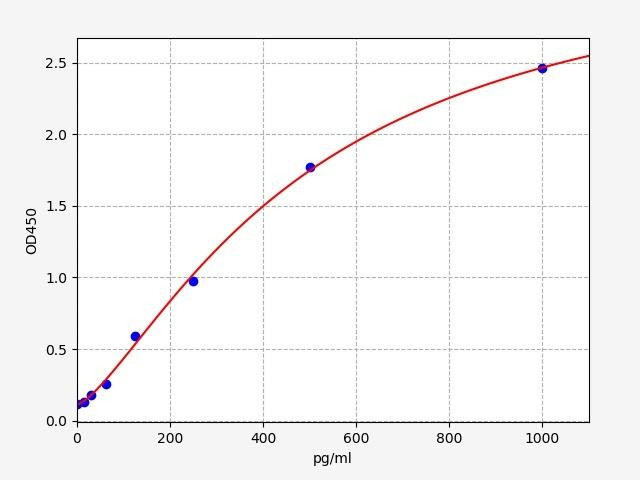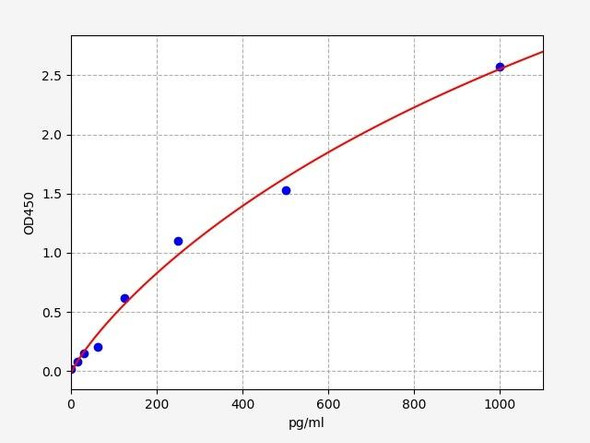IFN gamma is a cytokine involved in immune response and cellular immunity. The Monkey IFN Gamma ELISA kit is a specialized assay that accurately quantifies monkey IFN gamma levels, enabling researchers to study immune function and cytokine profiling in monkey models.
Description
Monkey IFN gamma ELISA Kit
Key Features
| Save Time | Pre-coated 96 well plate | |
| Quick Start | Kit includes all necessary reagents | |
| Publication Ready | Reproducible and reliable results |
Overview
| Reactivity: | |
| Product Name: | Monkey IFN-gamma (Interferon Gamma) ELISA Kit |
| Product Code: | MKFI00030 |
| Size: | 96 Assays |
| Alias: | IFN-gamma, IFNG, IFG, IFI, Type II Interferon |
| Detection Method: | Sandwich ELISA, Double Antibody |
| Reactivity: | Monkey |
| Sensitivity: | 18.75pg/ml |
| Range: | 31.25-2000pg/ml |
| Storage: | 4°C for 6 months |
| Note: | For Research Use Only |
Additional Information
| Recovery | Matrices listed below were spiked with certain level of Monkey IFN-gamma and the recovery rates were calculated by comparing the measured value to the expected amount of Monkey IFN-gamma in samples. Please contact us for more information. |
| Linearity: | The linearity of the kit was assayed by testing samples spiked with appropriate concentration of Monkey IFN-gamma and their serial dilutions. The results were demonstrated by the percentage of calculated concentration to the expected. . Please get in contact for more information. |
| CV(%) | Intra-Assay <8 Inter-Assay <10 |
Kit Components
| Component | Quantity | Storage |
| ELISA Microplate (Dismountable) | 8x12 strips | 4°C for 6 months |
| Lyophilized Standard | 2 | 4°C/ -20°C |
| Sample/Standard Dlution Buffer | 20ml | 4°C |
| Biotin-labeled Antibody (Concentrated) | 120ul | 4°C (Protection from light) |
| Antibody Dilution Buffer | 10ml | 4°C |
| HRP-Streptavidin Conjugate (SABC) | 120ul | 4°C (Protect from light) |
| SABC Dilution Buffer | 10ml | 4°C |
| TMB Substrate | 10ml | 4°C (Protection from light) |
| Stop Solution | 10ml | 4°C |
| Wash Buffer (25X) | 30ml | 4°C |
| Plate Sealer | 5 | - |
Other materials required:
- Microplate reader with 450 nm wavelength filter
- Multichannel Pipette, Pipette, microcentrifuge tubes and disposable pipette tips
- Incubator
- Deionized or distilled water
- Absorbent paper
- Buffer resevoir
Protocol
*Note: Protocols are specific to each batch/lot. For the exact instructions please follow the protocol included in your kit.
Before adding to wells, equilibrate the SABC working solution and TMB substrate for at least 30 min at 37°C. When diluting samples and reagents, they must be mixed completely and evenly. It is recommended to plot a standard curve for each test.
| Step | Procedure |
| 1. | Set standard, test sample and control (zero) wells on the pre-coated plate respectively, and then, record their positions. It is recommended to measure each standard and sample in duplicate. Wash plate 2 times before adding standard, sample and control (zero) wells! |
| 2. | Aliquot 0.1ml standard solutions into the standard wells. |
| 3. | Add 0.1 ml of Sample / Standard dilution buffer into the control (zero) well. |
| 4. | Add 0.1 ml of properly diluted sample ( Human serum, plasma, tissue homogenates and other biological fluids.) into test sample wells. |
| 5. | Seal the plate with a cover and incubate at 37 °C for 90 min. |
| 6. | Remove the cover and discard the plate content, clap the plate on the absorbent filter papers or other absorbent material. Do NOT let the wells completely dry at any time. Wash plate X2. |
| 7. | Add 0.1 ml of Biotin- detection antibody working solution into the above wells (standard, test sample & zero wells). Add the solution at the bottom of each well without touching the side wall. |
| 8. | Seal the plate with a cover and incubate at 37°C for 60 min. |
| 9. | Remove the cover, and wash plate 3 times with Wash buffer. Let wash buffer rest in wells for 1 min between each wash. |
| 10. | Add 0.1 ml of SABC working solution into each well, cover the plate and incubate at 37°C for 30 min. |
| 11. | Remove the cover and wash plate 5 times with Wash buffer, and each time let the wash buffer stay in the wells for 1-2 min. |
| 12. | Add 90 µl of TMB substrate into each well, cover the plate and incubate at 37°C in dark within 10-20 min. (Note: This incubation time is for reference use only, the optimal time should be determined by end user.) And the shades of blue can be seen in the first 3-4 wells (with most concentrated standard solutions), the other wells show no obvious color. |
| 13. | Add 50 µl of Stop solution into each well and mix thoroughly. The color changes into yellow immediately. |
| 14. | Read the O.D. absorbance at 450 nm in a microplate reader immediately after adding the stop solution. |
Sample Preparation
When carrying out an ELISA assay it is important to prepare your samples in order to achieve the best possible results. Below we have a list of procedures for the preparation of samples for different sample types.
| Sample Type | Protocol |
| Serum | If using serum separator tubes, allow samples to clot for 30 minutes at room temperature. Centrifuge for 10 minutes at 1,000x g. Collect the serum fraction and assay promptly or aliquot and store the samples at -80°C. Avoid multiple freeze-thaw cycles. If serum separator tubes are not being used, allow samples to clot overnight at 2-8°C. Centrifuge for 10 minutes at 1,000x g. Remove serum and assay promptly or aliquot and store the samples at -80°C. Avoid multiple freeze-thaw cycles. |
| Plasma | Collect plasma using EDTA or heparin as an anticoagulant. Centrifuge samples at 4°C for 15 mins at 1000 × g within 30 mins of collection. Collect the plasma fraction and assay promptly or aliquot and store the samples at -80°C. Avoid multiple freeze-thaw cycles. Note: Over haemolysed samples are not suitable for use with this kit. |
| Urine & Cerebrospinal Fluid | Collect the urine (mid-stream) in a sterile container, centrifuge for 20 mins at 2000-3000 rpm. Remove supernatant and assay immediately. If any precipitation is detected, repeat the centrifugation step. A similar protocol can be used for cerebrospinal fluid. |
| Cell culture supernatant | Collect the cell culture media by pipette, followed by centrifugation at 4°C for 20 mins at 1500 rpm. Collect the clear supernatant and assay immediately. |
| Cell lysates | Solubilize cells in lysis buffer and allow to sit on ice for 30 minutes. Centrifuge tubes at 14,000 x g for 5 minutes to remove insoluble material. Aliquot the supernatant into a new tube and discard the remaining whole cell extract. Quantify total protein concentration using a total protein assay. Assay immediately or aliquot and store at ≤ -20 °C. |
| Tissue homogenates | The preparation of tissue homogenates will vary depending upon tissue type. Rinse tissue with 1X PBS to remove excess blood & homogenize in 20ml of 1X PBS (including protease inhibitors) and store overnight at ≤ -20°C. Two freeze-thaw cycles are required to break the cell membranes. To further disrupt the cell membranes you can sonicate the samples. Centrifuge homogenates for 5 mins at 5000xg. Remove the supernatant and assay immediately or aliquot and store at -20°C or -80°C. |
| Tissue lysates | Rinse tissue with PBS, cut into 1-2 mm pieces, and homogenize with a tissue homogenizer in PBS. Add an equal volume of RIPA buffer containing protease inhibitors and lyse tissues at room temperature for 30 minutes with gentle agitation. Centrifuge to remove debris. Quantify total protein concentration using a total protein assay. Assay immediately or aliquot and store at ≤ -20 °C |
| Breast Milk | Collect milk samples and centrifuge at 10,000 x g for 60 min at 4°C. Aliquot the supernatant and assay. For long term use, store samples at -80°C. Minimize freeze/thaw cycles. |
Interferon Gamma (IFN Gamma) Background
Interferon Gamma (IFN Gamma) Background
Interferon gamma (IFN-γ), or Type II interferons, a key cytokine in the immune system, is produced by various immune cells, including T cells, natural killer (NK) cells, and macrophages. It is primarily secreted in response to infections, particularly those caused by viruses and bacteria, but can also be induced by other immune stimuli. IFN-γ exerts its effects by binding to specific receptors on target cells, triggering a cascade of signaling events that ultimately modulate the immune response. It plays a crucial role in activating macrophages, enhancing their ability to eliminate intracellular pathogens. Additionally, IFN-γ promotes the differentiation of T helper 1 (Th1) cells, which are involved in cellular immune responses, while inhibiting the development of T helper 2 (Th2) cells, which are associated with humoral immune responses.
IFN Gamma gene
The gene encoding interferon gamma, known as IFNG, is located on human chromosome 12 (Location 12q14). It consists of four exons and three introns. The IFNG gene exhibits a high degree of polymorphism, meaning that it has multiple variations (alleles) in the population. These genetic variations can influence the production and activity of IFN-γ, leading to differences in immune responses among individuals. Polymorphisms in the IFNG gene have been associated with susceptibility or resistance to various infectious diseases, autoimmune disorders, and other immune-related conditions. Genetic studies have helped elucidate the role of IFN-γ in different disease contexts and shed light on the complex interplay between the gene, protein, and immune response.
IFN Gamma Structure
At the protein level, interferon gamma is a dimeric molecule composed of two identical subunits. Each subunit consists of 143 amino acids, and the protein has a molecular weight of approximately 16 kDa. The structure of IFN-γ is compact and globular, stabilized by disulfide bonds. It belongs to the class of helical cytokines and shares structural similarities with other interferons.
Structure of Human IFN-Gamma. Source: Uniprot
IFN Gamma Receptor and IFN Gamma Signalling
The interferon gamma receptor (IFN-γR) is a transmembrane protein that serves as the primary receptor for interferon gamma (IFN-γ). It is composed of two subunits: IFN-γR1 and IFN-γR2. IFN-γR1 is responsible for ligand binding, while IFN-γR2 is involved in signal transduction. Both subunits are necessary for the formation of a functional receptor complex.
When IFN-γ binds to IFN-γR1, it induces a conformational change that allows the recruitment and phosphorylation of Janus kinases (JAKs), specifically JAK1 and JAK2. These activated JAKs phosphorylate tyrosine residues on the receptor subunits, creating docking sites for signal transducer and activator of transcription (STAT) proteins.
In addition to the JAK-STAT pathway, IFN-γ can also activate other signaling pathways, such as the mitogen-activated protein kinase (MAPK) pathway and the phosphoinositide 3-kinase (PI3K) pathway. These pathways can modulate various cellular processes, including cell growth, differentiation, and survival.
The activation of these signaling pathways by IFN-γ ultimately results in the regulation of numerous genes involved in immune responses, inflammation, and antimicrobial defense. This includes the upregulation of genes encoding antimicrobial peptides, major histocompatibility complex (MHC) molecules, and other proteins involved in antigen presentation and immune cell activation.
IFN Gamma and disease
The signaling pathways triggered by IFN-γ are tightly regulated to ensure proper immune responses and prevent excessive inflammation. Dysregulation of IFN-γ signaling can have significant implications for immune function and contribute to the pathogenesis of various diseases, including autoimmune disorders and infectious diseases.
Interferon gamma plays a significant role in the pathogenesis of various diseases. In some cases, excessive or prolonged production of IFN-γ can contribute to autoimmune disorders, such as multiple sclerosis, rheumatoid arthritis, and systemic lupus erythematosus. Conversely, reduced production or impaired signaling of IFN-γ can lead to increased susceptibility to infections, particularly mycobacterial and viral infections. IFN-γ-based therapies have been explored in the treatment of certain cancers, including melanoma and chronic myelogenous leukemia, with the aim of enhancing the immune response against tumor cells. Moreover, IFN-γ has been used in the treatment of chronic granulomatous disease, a rare genetic disorder characterized by defective immune cell function. However, the use of IFN-γ in therapy requires careful consideration of its potential side effects and the specific context of the disease being treated. Ongoing research continues to uncover the complexities of IFN-γ's involvement in disease and its potential as a therapeutic target.
Monkey IFN Gamma ELISA Kit FAQs
Q: What is the purpose of the UNC13A ELISA kit?
IFN-γ ELISA kit is a specialized assay kit designed to quantitatively measure the levels of monkey interferon gamma in biological samples. It utilizes the enzyme-linked immunosorbent assay (ELISA) technique, which allows for precise and sensitive detection of IFN-γ. The kit is used to study the immune response, inflammation, and cytokine profiling in monkey models.
Q: What type of samples can be used with the UNC13A ELISA kit?
The IFN-γ ELISA kit is compatible with a wide range of sample types, including serum, plasma, cell culture supernatants, and other biological fluids. It is important to follow the specific sample preparation instructions provided with the kit to ensure accurate and reliable results.
Q: Can the Monkey IFN Gamma ELISA kit be used with other species?
The IFN-γ ELISA kit is designed to specifically detect monkey IFN-γ. The antibodies used in the kit have been carefully selected to ensure high specificity for monkey IFN-γ and minimal cross-reactivity with other cytokines or species. However, it is always recommended to confirm the specificity of the kit using appropriate controls and validation experiments.
Q: Where can I find additional technical support or assistance with the UNC13A ELISA kit?
For any technical inquiries or assistance regarding the UNC13A ELISA kit, you can reach out to our team. They will be available to answer your questions and provide the necessary guidance to ensure a successful experiment.
Related Products

| Monkey IFN alpha / Interferon Alpha ELISA Kit | |
|---|---|
| ELISA TYPE: | Sandwich ELISA, Double Antibody |
| SENSITIVITY: | 9.375pg/ml |
| RANGE: | 15.625-1000pg/ml |

| Human IFN gamma ELISA Kit | |
|---|---|
| ELISA TYPE: | Sandwich ELISA, Double Antibody |
| SENSITIVITY: | 9.375pg/ml |
| RANGE: | 15.625-1000pg/ml |

| Human IFN alpha / Interferon Alpha ELISA Kit | |
|---|---|
| ELISA TYPE: | Sandwich ELISA, Double Antibody |
| SENSITIVITY: | 9.375pg/ml |
| RANGE: | 15.625-1000pg/ml |






